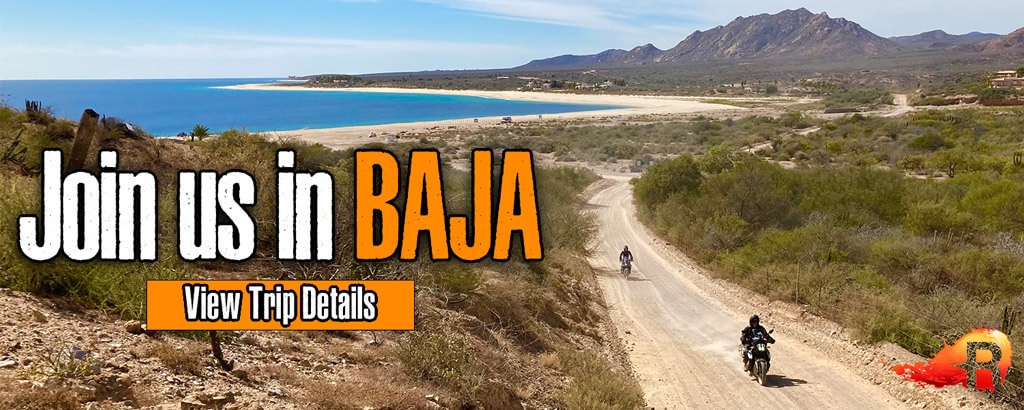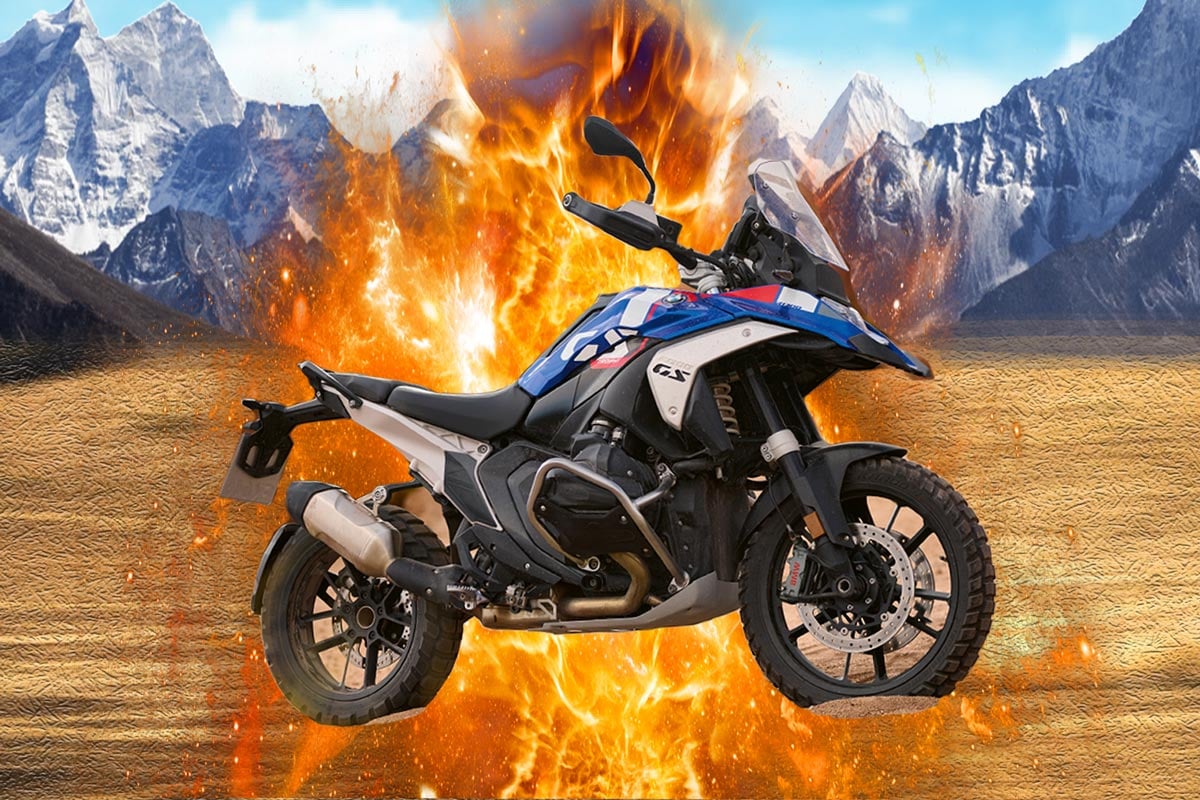 The BMW 1300 GS is a ground-up redesign of one of the most iconic motorcycles of all time. Has BMW jumped the shark with the new GS, or is a lighter, more powerful boxer what we needed all along?
The BMW 1300 GS is a ground-up redesign of one of the most iconic motorcycles of all time. Has BMW jumped the shark with the new GS, or is a lighter, more powerful boxer what we needed all along?
The BMW GS has always been a divisive machine. Loyalists love it for its rich history, outstanding road manners, and globe-trotting versatility, while haters hate it for its polarizing looks, middling performance, and utilitarian design.
This year, BMW has done the unthinkable with a clean-sheet reimagining of what a GS should be. The BMW 1300 GS is lighter, more compact, and more powerful than ever, but has BMW made a mistake by messing with success?
Below we'll take a deep dive into the brand new BMW GS, digging into its new design, updated technology, and industry-first innovations. Before we get into that though, let's take a quick walk through the GS museum to better understand what makes the BMW 1300 GS such a significant machine.
The History of the BMW GS Adventure Bike
We probably don't need to tell you that the BMW GS is the most iconic name in adventure riding. Truth be told, we probably wouldn't have an adventure segment at all had the first GS not rolled off the BMW assembly line back in 1980, and it's been a hell of a ride ever since.

"The original R80GS remains one of the most iconic motorcycles of all time, and effectively gave birth to the adventure segment we know and love today." Photo courtesy of "Deutsches Zweirad- und NSU-Museum" (e-Mail 17.08.2006 13:14) - With many thanks to Ms. Dumas & Ms. Grams"
With that being said, the original GS was unrecognizable from what we now think of when discussing BMW's flagship ADV. The original R80G/S still had a boxer twin engine as well as a shaft final drive, but the similarities more or less end there.
The comparatively small 797cc engine of the original model was a bare-bones air-cooled design, which it shared with the increasingly rare R80ST road bike. This engine was known for its reliability, easy maintenance, and low down torque, and proved robust enough to conquer the infamous Paris-Dakar rally on three separate occasions in the 1980s.
This era of GS, affectionately known as the "airhead" period, continued with considerable popularity well into the early 1990s. The airhead GS saw a few major upgrades including an improved rear suspension system, a larger 980cc engine (aka the R100GS), and the addition of a rally-inspired front fairing, but the airheads were officially phased out going into the 1994 production year.
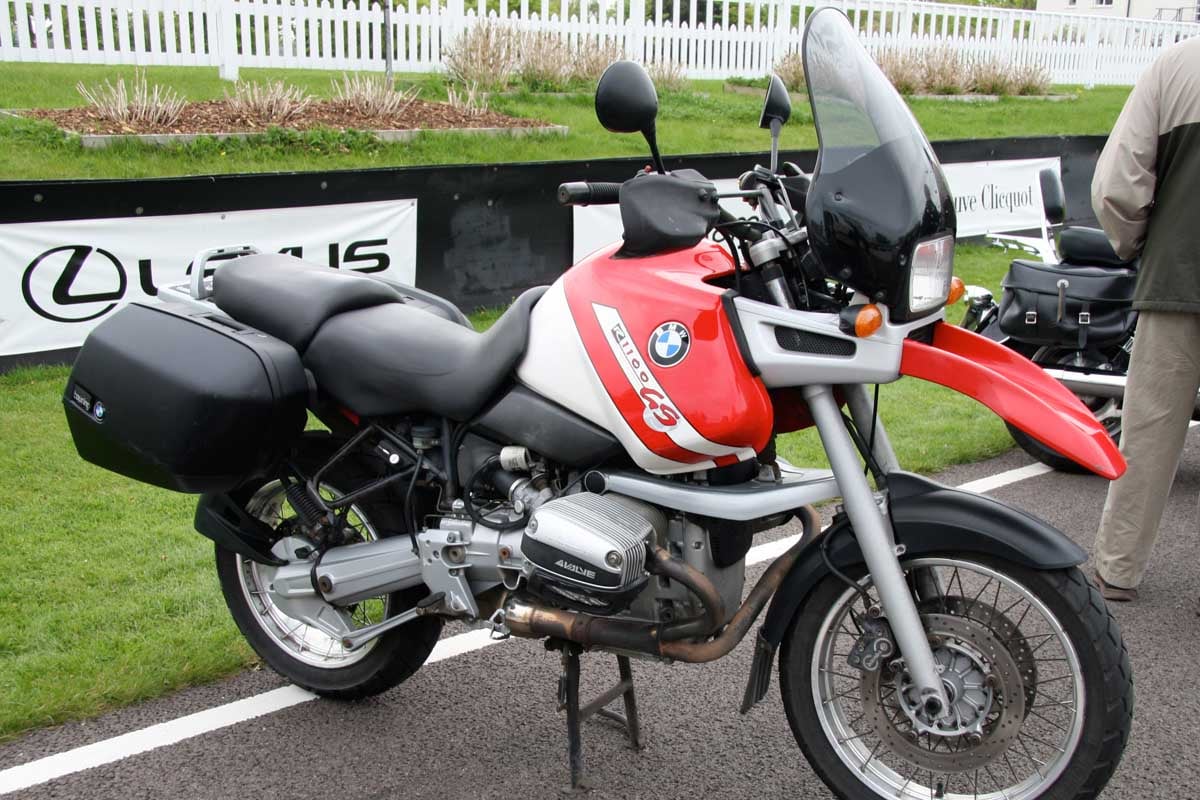
"Many of the GS' trademark features started with the original oilheads, including the distinctive "Telelever" front suspension"
- By courtesy of Wikipedia from author Brian Snelson
Thus began the era of the "oilhead" GS, and for many riders, the beginning of the big adventure bike we all recognize today. Engines were bumped to 1,085cc, the now trademark Telelever front suspension was introduced, and (as the name suggests) the old air-cooled design was exchanged for a more modern oil-cooled approach to keep up with the higher output of the new four-valve per cylinder heads.
From there BMW moved on to the legendary R1150GS in 1999, adding a larger 1,130cc engine, a new six-speed transmission, and for the first time ever, a dedicated "Adventure" model aimed squarely at the off-road touring community. Slowly but surely the GS was becoming the comfortable and capable land yacht we all know today, and many owners swear to this day the 1150 model remains the best GS ever made.
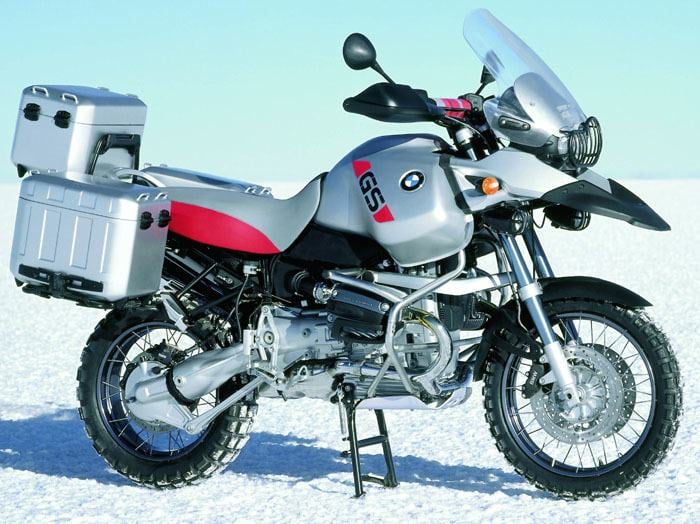 "The 1150 series found fame and newfound public interest as the star of the popular television series 'Long Way Round.'"
"The 1150 series found fame and newfound public interest as the star of the popular television series 'Long Way Round.'"
Oilheads stuck around for quite some time, getting an additional bump in displacement with the R1200GS in 2004, which marked the first time in history that a GS made over 100 horsepower. The final iteration of the beloved oilhead came in 2012, after which BMW made the controversial decision to switch to a water-cooled powerplant for the 2013 model year.
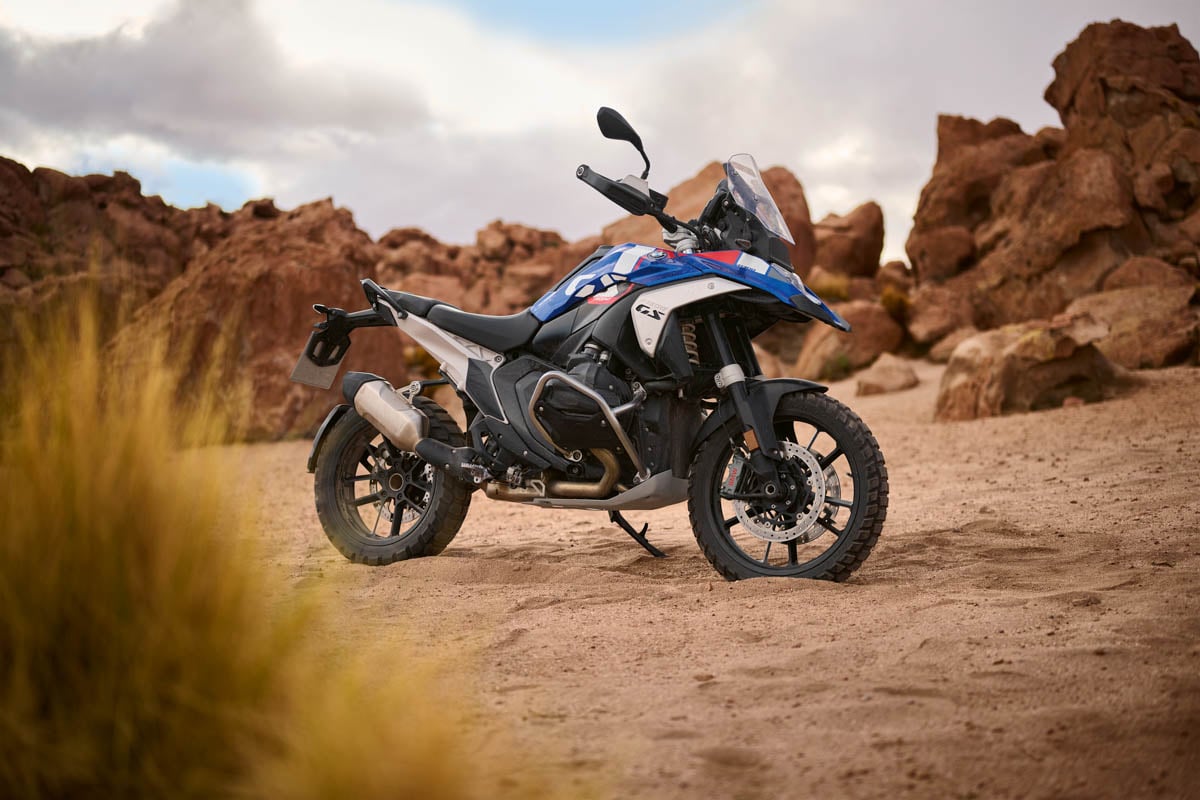
"It's all led up to this: the new 1300 GS enters uncharted territory for BMW."
The following years saw some major updates including variable valve timing, smartphone connectivity, semi-active suspension, and a full suite of modern rider aids including lean-sensitive ABS and multiple rider modes. The GS has come a long way from its humble roots in desert racing, but as you'll read below, there's never been a change quite so significant as the new 2024 BMW 1300 GS.
2024 BMW 1300 GS Overview
All new everything: That's the big headline with the new BMW 1300 GS and its ground-up redesign. While at first glance it may seem like BMW is taking a big risk with their flagship ADV, we believe GS fans everywhere are in for a pleasant surprise.
Powertrain, Frame, Chassis
Starting with the biggest change first, discerning ADV aficionados will immediately notice that BMW has moved away from a hallmark of the GS design: The trellis frame is no more, and in its place is an all-new stamped steel chassis.
BMW's aim here is simple: A lighter, more compact, and overall "tighter" package for the new era of GS. As you'll read below, this is a theme we'll see throughout the bike, but the significance of this change can't be overstated.
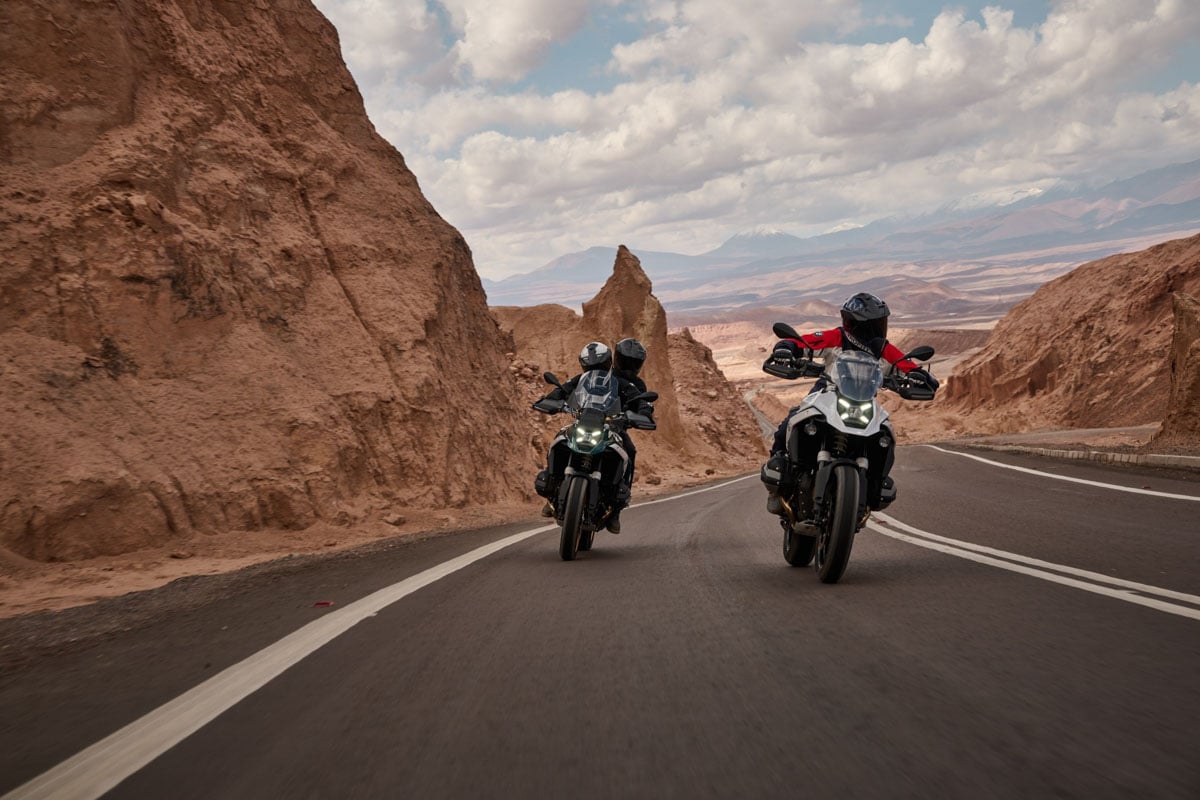
"The new GS is offered in four distinct trim levels, but the base model starts at under $19,000."
The second major update here is the engine. BMW's new 1,300cc water-cooled boxer is by far the most powerful iteration of the engine yet, and its oversquare dimensions deliver a whopping 145 claimed horsepower at 7,500rpm, marking a 9hp gain over the outgoing 1250GS.
While extra power is always welcome, the most remarkable aspect of the new powertrain is the transmission. The BMW 1300 GS ushers in a completely new layout for their 6-speed gearbox, which now sits directly underneath the motor rather than behind it.
The benefit here is substantial: By shortening up the entire powertrain, BMW is able to shift the lion's share of the GS' mass further forward, improving the overall responsiveness of the bike. This also allowed them to move the single-sided swingarm pivot lower on the chassis, which reduces the angle (and therefore stress) on the drive shaft's U-joints.
These two major changes also contribute to the bulk of the BMW 1300 GS' weight savings. BMW claims the new standard model is a whopping 26 pounds lighter than the outgoing 1250, which is a giant leap in the right direction for this iconic ADV.
Suspension
The BMW 1300 GS also ushers in a new era of suspension technology as the first ever motorcycle to feature electronically adjustable damping, preload, and spring rates. This is an important industry first, and we're both surprised and impressed to see it coming from the folks at BMW Motorrad.
The new system works by utilizing two springs on either end of the bike. One is a conventional spring with a set rate, while the other is a smaller unit enclosed in a remote reservoir with separate fluid damping.
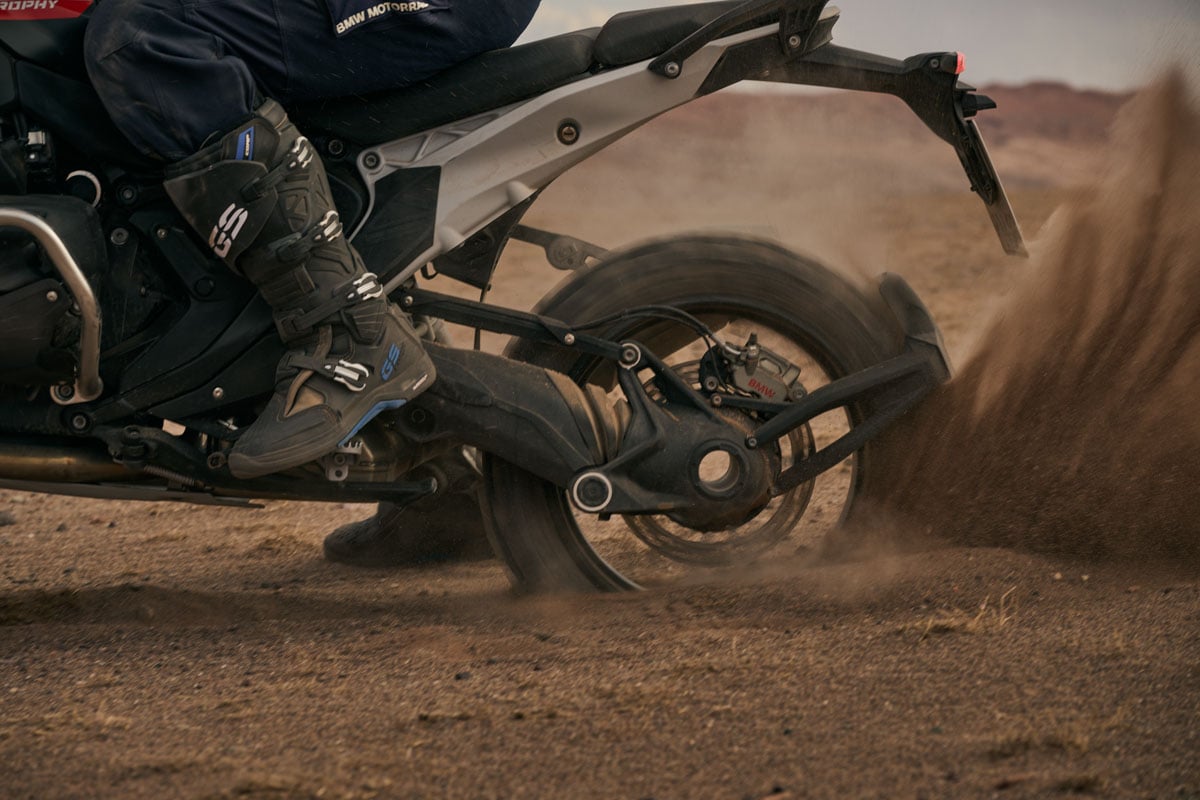
"By shortening the engine, BMW was able to lengthen the GS' swingarm for improved handling and stability."
By electronically adjusting the damping rate of the smaller spring, the new BMW 1300 GS is effectively able to alter spring rates on the fly. This means that for the first time preload, damping, and spring rate will be automatically adjusted to accommodate for the load on the bike whether you're riding solo, weighed down with luggage, or bringing along a passenger.
The 1300 also includes an adaptive ride height feature, which riders with a shorter inseam will appreciate. We've experienced this before on the Harley Pan America and Triumph Tiger 1200, and expect BMW's take to be just as seamless and effective.
Tech and Electronics
While the BMW 1300 GS comes with all the usual bells and whistles you'd expect in a modern ADV, it's also got a new trick up its sleeve the touring crowd will appreciate: Radar.
Yes, the new GS joins the Ducati Multistrada and KTM Super Adventure on the Bosch-equipped adaptive cruise control scene, and if it's anything like what we recently experienced on the latest Multistrada V4 Rally, we're all in for a treat.
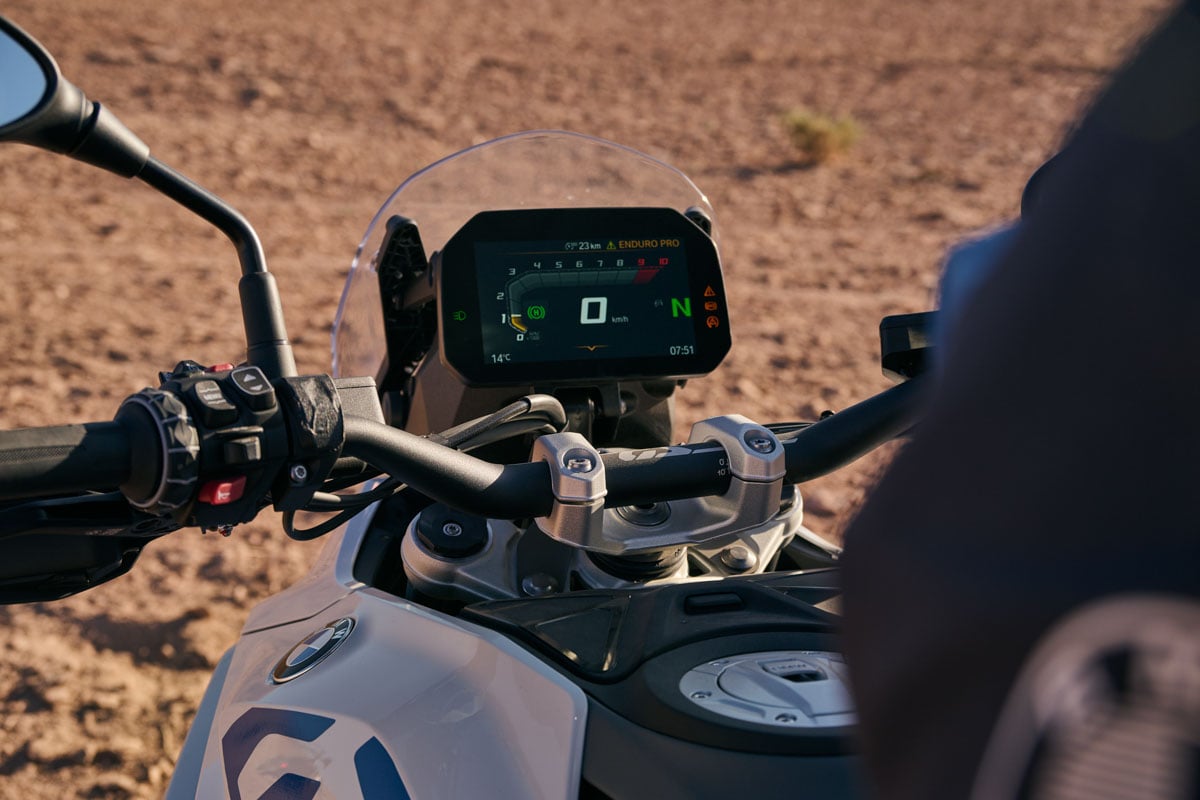
"The bright TFT dash on the 1300 GS remains one of the best in the business."
The Bosch system allows riders to set a speed as well as a "following distance" from vehicles ahead, then modulates the throttle automatically to maintain a comfortable cruise. BMW also elected to include accident mitigation as part of the radar package, which will apply braking in a crash scenario to safely reduce speeds as much as possible before an impact.
Owners will also get a wide selection of rider modes, which includes three modes for road riding (eco, rain, and road), new "dynamic" modes that allow for rear wheel drift (GS supermoto anyone?), and "enduro" modes with fully selectable ABS for more trecherous terrain.
2024 BMW 1300 GS Specs
MSRP: $18,895
Engine
- Engine: Liquid-cooled twin-cylinder boxer
- Displacement: 1,300cc
- Bore x stroke: 106.5mm x 73mm
- Compression: 13.3:1
- Transmission: 6-speed manual
- Final drive: Shaft
- Horsepower: 145 hp @ 7,750 rpm
- Torque: 110 lb-ft @ 6,500 rpm
- Redline: 9,000 rpm
- Fueling: Electronic injection
- Clutch: Wet/slipper assist, hydraulic
Chassis, Suspension, and Brakes
- Frame: Stamped steel, engine as a stressed member
- Front suspension: EVO-Telelever
- Front travel: 7.5”
- Rear suspension: EVO-Paralever, spring preload fully adjustable
- Rear travel: 7.9”
- Front brakes: Twin disk, 310mm, 4 piston radial calipers
- Rear brakes: Single disk, 285mm, 2 piston floating caliper
- ABS: Yes, lean angle sensitive
- Wheels: 19"x17", aluminum cast
- Tires: Metzler Tourance Next 2, 120/70 front, 170/60 rear
Dimensions/Capacities
- Rake: 63.8*
- Trail: 4.4"”
- Wheelbase: 59.8"”
- Seat height: 33.4”
- Fuel capacity: 5.0 gal.
- Weight: 523 lbs (with fuel and fluids)
Our Take on the 2024 BMW 1300 GS
Pros
- New and improved everything
- Hasn't lost that beloved GS feel
- Impressive tech and accessories on offer
- Competitive starting MSRP
First impressions of the new GS are positive all around. Existing GS devotees are getting a clean-sheet redesign that stays faithful to the bike's iconic character, while the rest of us are getting an enticing new take that's lighter, more compact, and seemingly more capable on road and off.
We love that while the BMW 1300 GS is lighter and more powerful than ever, its clear that BMW isn't chasing horsepower figures with their big ADV. Whether we care to admit it or not, most riders simply have no need for 180+ ponies, and the new GS delivers the thrills without sacrificing the big boxer's easy-going and torque-laden nature.
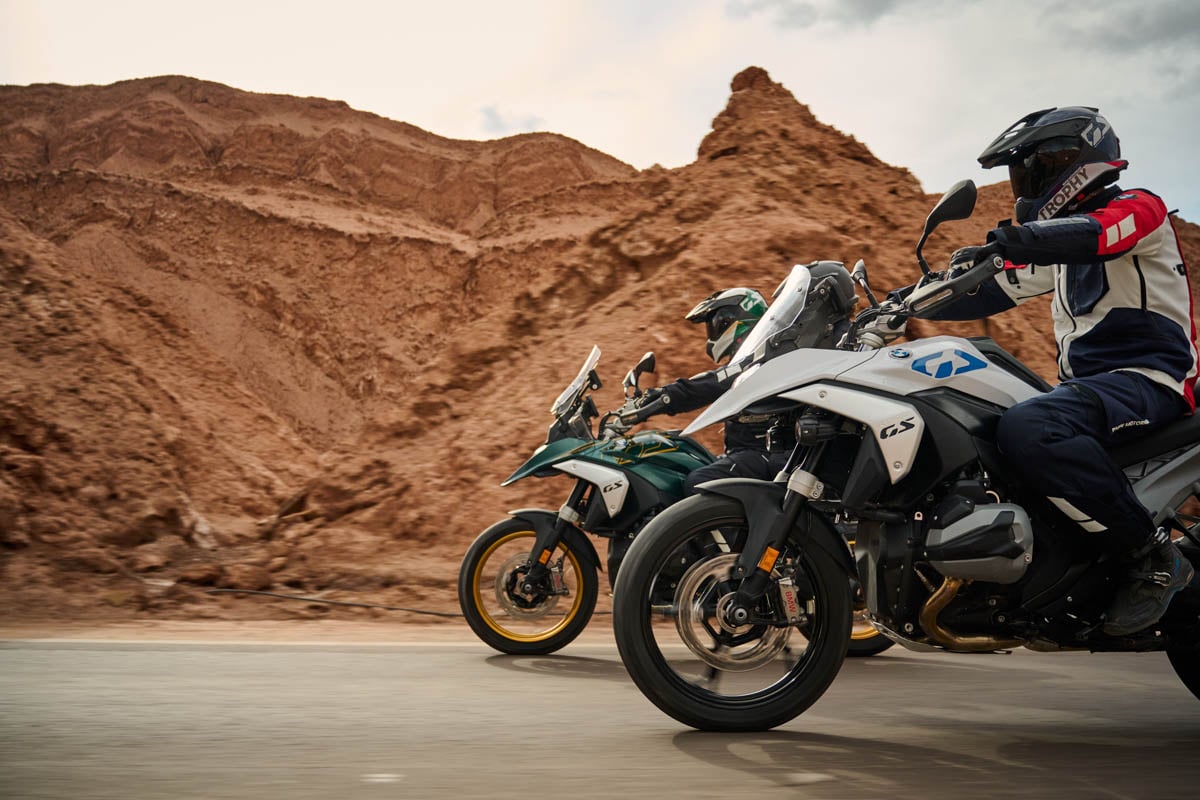
"While much has clearly changed, it's clear BMW was careful not to compromise the GS' mile-munching character."
With that being said, it's clear that BMW cut no corners here. Rather than doubling down on outright engine performance, the BMW 1300 GS represents a massive investment in real-world usable R&D, delivering what is quite possibly the most advanced and impressive touring suspension we've ever seen on an adventure bike.
The GS has always been a long distance road warrior first and foremost, but it's never been afraid to tackle a dirt road either. The BMW 1300 GS raises the bar for BMW owners in both regards without doubling down on either aspect, which we suspect will make the new GS the most appealing all-rounder yet.
Cons
- New style is a big departure from "classic" GS look
- Can't compete with the road prowess of the Multistrada
- Can't compete with the dirt prowess of the Super Adventure
As far as drawbacks go, we aren't seeing much to complain about with the new 1300. In terms of performance and technology, the new bike has everything it needs to bring the iconic GS into the modern era, ready to compete with the latest and greatest in the segment.
With that being said, we believe the single biggest issue most riders will have with the GS is that it doesn't directly compete with other premium offerings in the segment. It simply can't touch the fire-breathing V4 of the latest Multistrada, nor can it compete with the off-road prowess of KTM's 1290 Super Adventure.
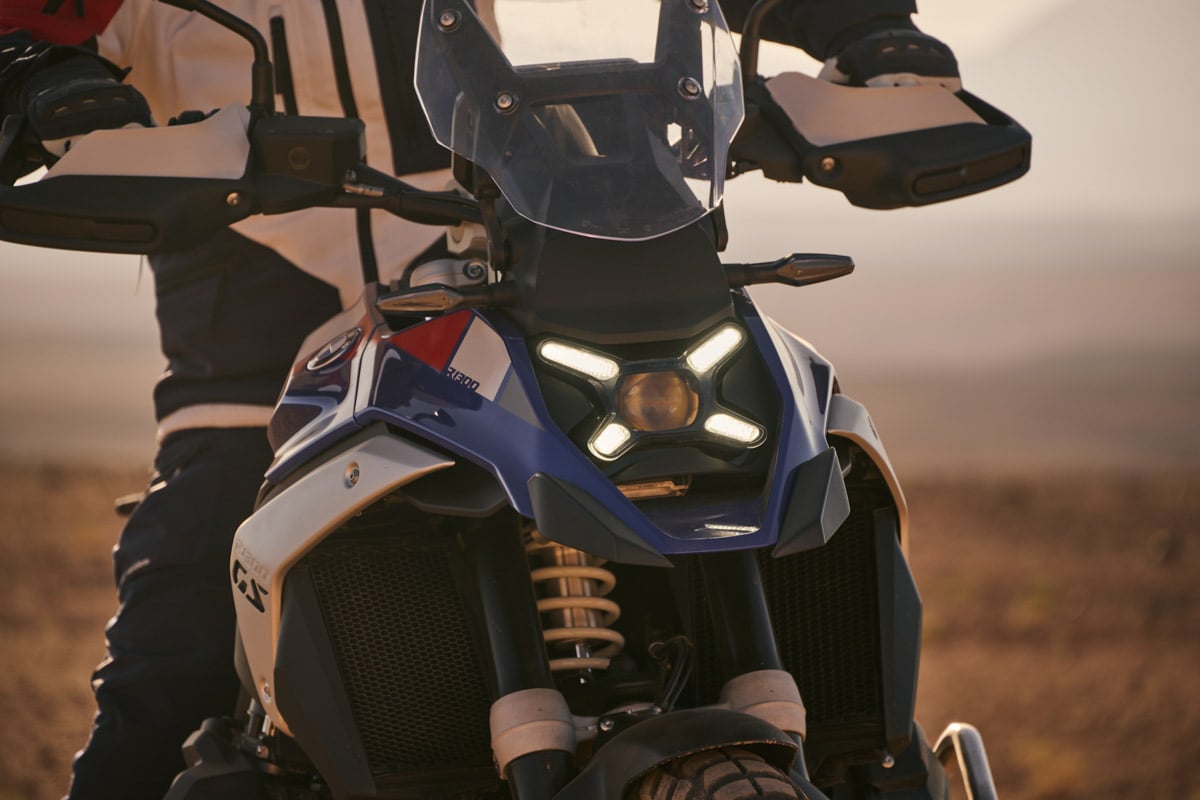
"The asymmetric headlight is gone, but the GS' styling remains as polarizing as ever."
Apart from that, we believe the single biggest issue for most prospective buyers will come down to style. We have no doubt there's an angry mob out there somewhere mourning the loss the trademark asymmetric headlight that's adorned the GS since the oilhead era, but we suspect there will be just as many fans on the other side of the fence glad to see it go.
Final Thoughts On the 2024 BMW 1300 GS
Say what you will about the BMW GS and the folks who own them: this bike has earned a ravenously loyal following over the last few decades. The latest BMW 1300 GS looks like a serious departure from form on paper, but as anyone who's owned a GS will tell you, this bike has always been more than what you read in the brochure.

"Nothing draws the local crowd like a shiny new GS."
For all intents and purposes, we feel BMW has knocked this one out of the park. The 1300 GS is a new and exciting bike that improves on the previous model in every way while still maintaining (if not enhancing) the personality and character that's always made the GS a great ride.
It may not compete with KTM's competence in the dirt or Ducati's prowess on a twisty road, but as the world's greatest big all-rounder, BMW remains king. Class-leading comfort and road manners are still on offer with the BMW 1300 GS, and there's simply no denying that the big adventure remains one of the most attractive bikes on the planet if factory farkles are your bag.
→READ MORE: 2021 Yamaha Tenere 700 Review: The Good and the Bad and The Best (and Worst) Times to be Standing on a Motorcycle.






